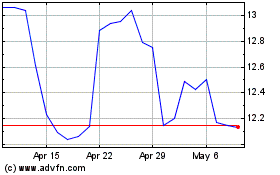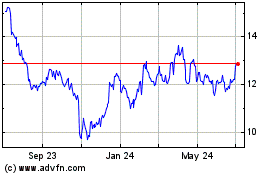Ford Offers Guarded View On Affordability of Leases -- WSJ
March 24 2017 - 3:02AM
Dow Jones News
Auto maker expects higher interest rates, decline in used-car
values to hurt affordability
By Christina Rogers and John D. Stoll
Ford Motor Co. raised a caution flag for the auto industry,
saying higher interest rates and a steady decline in used-car
values will hurt the most important factor in the recent U.S. sales
boom: affordability.
The outlook, coming as the company forecast leaner results for
the first quarter, comes amid a broader view that car sales in the
world's two largest markets have peaked after a string of record
profits and sales for the U.S. auto industry. Ford estimates
volumes will fall in the U.S. and China in 2017 and again in
2018.
The U.S. market has been buoyed by customer access to cheap
leases and long-term loans that come with low interest rates. The
Federal Reserve is pushing interest rates higher, potentially
crimping retailers' appetites to dole out the 0% loans that have
fueled demand.
A flood of preowned vehicles are going on sale, a product of a
leasing boom that has accelerated in recent years is heightening
concern. Leasing has become a popular way to finance vehicle
purchases, allowing buyers to borrow a car for two or three years
at a subsidized rate and return it at the end of the term -- many
of which are expiring this year.
As more preowned cars become available, the price of a
gently-used vehicle is falling. While that could force auto makers
to ramp up sales incentives, it also could make leasing less
attractive because leases are often cheaper on vehicles that are
expected to have strong resale values.
"We do think there will be people who fallout and they won't be
able to afford a new vehicle," Ford Chief Financial Officer Bob
Shanks said, speaking to analysts Thursday. Rising interest rates
and tightening credit will further inflate car prices, and some may
find better value in online classifieds or on used-car lots.
A clutch of Ford's rivals, including Toyota Motor Co. and BMW
AG, have voiced concern about the impact the used market is having
on car prices and the performance of their internal credit arms.
About 25% of Ford Credit's balance sheet, for instance, is made up
of leasing assets -- at General Motors Co.'s GM Financial that
number exceeds 40%.
Cheap leases are possible because car makers pay a subsidy that
is based on the forecast value of the car at the end of the lease.
Mr. Shanks said Thursday the auto maker has had to change those
residual-value calculations recently based on data furnished by the
National Automobile Dealers Association and other third
parties.
Car buyers tend to make buying decisions based on monthly
payments instead of sticker price. Edmunds.com estimates the
average monthly car payment for a vehicle purchased in February was
$515, up only 6% from the $487 buyers paid in February 2007.
Over the same period, the amount financed by new car buyers has
skyrocketed 23%, from $25,003 to $30,753, the firm said.
In addition to subsidized leases, the disparity between car
payments and purchase prices over the period has been low borrowing
costs. The average loan was written with a 4.9% interest rate, more
than 2 percentage points less than the 2007 loans.
Ford also said Thursday it expects full-year adjusted operating
profits of $9 billion this year, a 14% decline over 2016, due to
higher costs and continued investment in autonomous cars and other
advanced technologies. The company also guided to first-quarter
earnings per share of between 30 cents and 35 cents, lower than the
same-period a year earlier and far below analysts' expectations of
47 cents.
Higher engineering costs, the strong dollar, rising warranty
costs and commodity price increases are reasons for the weaker
performance. Lower volumes are also expected to weigh on the
performance.
Lower-than-anticipated quarterly guidance further confirms Wall
Street's view that auto makers are too exposed to cyclical swings
in the car business.
Ford, coming off several years of record profitability, has
pledged billions in new investment in electric cars and autonomous
vehicles, aiming to catch up with both rivals inside the auto
industry and new tech startups entering the car business. Auto
makers are under pressure to meet tightening U.S. regulatory
standards and are in a race to reinvent the automobile
business.
Pressure on Ford's bottom line comes as its two main rivals, GM
and Toyota, also encounter turbulence. Earnings for both companies
in the profitable North American market slumped in the most recent
financial quarter amid a growing price war in the U.S.
Write to Christina Rogers at christina.rogers@wsj.com and John
D. Stoll at john.stoll@wsj.com
(END) Dow Jones Newswires
March 24, 2017 02:47 ET (06:47 GMT)
Copyright (c) 2017 Dow Jones & Company, Inc.
Ford Motor (NYSE:F)
Historical Stock Chart
From Mar 2024 to Apr 2024

Ford Motor (NYSE:F)
Historical Stock Chart
From Apr 2023 to Apr 2024
